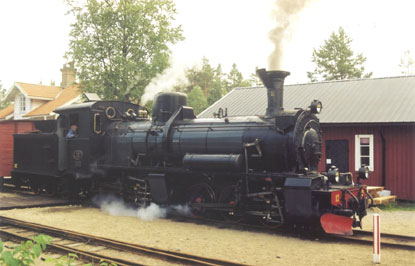
One of the ungue engines in Sweden were the three 0-6-6-0.s of DONJ, of two engines No.8 and No.12 has survied on JTJ.
Here No.12 taking a train with passengers stops in Tallås in summer 2001.
Photo by Ollie Ahokas
Pictures here are taken in July 2002. and are clickable for a larger view.
Brief History on DONJ.
Sweden had a rich variation of narrow-gauge railways mostly constructed during the last three decades of the 19.th century. The common carriers varied from 600mm to 1093mm gauge and all were constructed as private lines with local interests. To make it more correct, a number of industrial lines were also operated. But as the motor traffic on improved public road increased, the revenue on the local lines declined, most of them ended their service during the depression years during the thirties, and some others survived to the sixties after the post-war nationalization of the former private lines. The nationalization meant that the former, rather varied motley collection of equipment was replaced by new standardized SJ constructions, before they were finally shut down. One of the survivors, DONJ, did not get nationalized and kept its own power to the end of the operation in 1970. A small part of the line around the operation hub of Jädraås is run as a preserved railroad at Sundays every summer. Today only two of the narrow gauge lines has survived as common carriers Roslagsbanan that has transformed itself in to a feeder line northern Stockholm and VHVJ that operates in south east of Sweden, serving as a long tourist line.

The oreyard of Jädraås, during the first WW. The mallet is here converted to be fired with wood and a ballon stack replaced the orginal one due the wartime shortage of coal. The engine was converted back to coalfired and lost the ballon stack in the progress. Note the owens in the backgroumd.
In the village of Wintjärn discovery of rich vein of iron ore led in to construction of a mine. This led in to the blast furnaces were constructed to at the waterways in Åmot and in Jädraås. But this meant a problem of transportation of the ore to the blast furnaces through the woods. First for decades the horse driven sleighs in winter and wagons were used but need of better way to get ore to the mills was discussed, the alternatives were new road strong enough to support the weight of steam-powered dinkeys or a narrow gauge railroad.
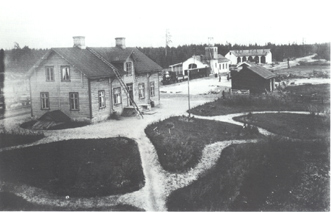
In 1872 the railroad alternative won and in 9.th of August year 1876 the line between Wintjärn and Lilla Björnmossen was opened for service, in all 10.9 km. Before this first leg was finished studies for to construct the line further to east to Tallås. In the beginning the the line rostered one small steamer and a 12 simple orecars. As the line was extended 12 more orecars were ordered. During this time a study of a line from Tallås to Åmot would be to expensive to construct, and this led to a concentration to the blast furnace and works in Jädraås. As a part of this expansion the line was extended to Jädraås. The owners of the line and the mining company, Ockelbyverken sold the company to a timbercompany, Kopparberg & Hofors Såg AB in 1887. The line was extended from Wintjärn to west to the sawmills of Linghed. This expansion needed 3 more engines (2-6-0T.s) and a 50 flatcars to handle the timber, slowly the line was changing from ore hauler to a loggingline.
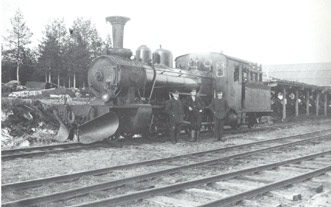
The first of the tenderengines were the three 2-8-0.s from Falun, which were all scrapped in the fifties. Here we see one of the gons resting in Svartbäcken. One of their sister engines, BLJ 5 runs on the preserved ULj line during the summer months from the city of Uppsala.
The new owners concentrated their activities to a small coastal town of Norrsundet where they invested in a paper mill, and the line was extended to east in 1890 the line reached to the town of Ockelbo, and in September, 1895 the first train reached the not finished yard of Norrsundet. To meet the opposition in Ockelbo the line was changed to a common carrier, which lead to the company invested in few small passenger cars and a number of baggage cars that doubled also as cabooses and boxcars.
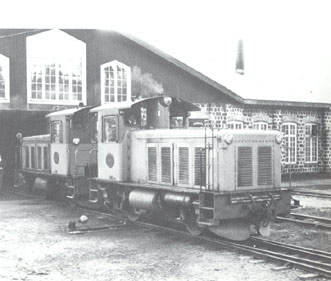
Half of the mainline units resting at the shops in Jädraås. These engines were troublesome and a mallet was kept as reserv to the end of the operation.
The operation hub for this in all 86 km of mainline plus few brances was Jädraås, where the shops were also located. New engines was needed to the line, in 1900 two tankengines arrived to the line, one of them was a 0-6-2T from Baldwin, which in time lost its American looks and Nohab deliverd No.7, a small second hand engine and home built chaindriven stamtanks completed the roster during this period. The latter ones were used as a swithcers in the paper mill.
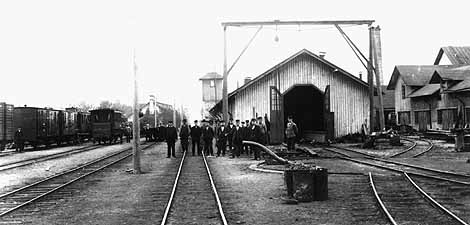
The orginal shop of DONJ, in Jädraås. This building was destroyed by a fire and replaced by the current one in the 1910.
The first of the tender engines a trio of Falun built 2-8-0 arrived in 1906 (No.s 9-11). Followed by three 0-6-6-0.s from Atlas in Stockholm. By this time some engines were wearing out because of this the engines were numbered as No.1, 8 and 12. Two more secondhand tank engines No.13 and 14 were purchased and used mainly for light runs and as a mill switchers. Need for more cars for hauling timber and charcoal and to replace older cars led into more than 300 cars wer contructed or purchased untill 1961. During the fifties and sixties majority of the steamengines were scrapped and a quartett of small 0-4-0 MU.able 2 and 2 replaced the steam. During the sixties a pair of larger centercab diesel was leased to haul timber, while the two of the remaining Mallets were kept as reservpower for these troublesome diesels. The roster was rounded up by a couple of critters purchased from SJ. The last run on the line was in 1970 and the line was dismandeled, except for the portion Jädarås and halfways to Svartbäcken which now a preserved railroad and the line from SJ mainline to Norrsundet, which was regauged to standard gauge and still serves the huge paper mill.
Jädraås today.
There are only a few places that takes you back to age of steam as much as Jädraås. Besides Nora, this site is complete with its roundhouse, depot and ALL shopbuildings intact.

Two aspects, iron and rail dominate the small community of Jädraås. The blast furnaces and the foundry, which is slowly rebuilt from ruins, are a testimony of the industrializing in the 19.th century. Add on the decision to locate all of what was needed to operate a narrow gauge line turned an isolated village from being a ghost town in the middle of the woods. Jädraås is not a big town, not even a large village only a handful of houses, a combined gas station and convience shop, and increasing numbers of small enterprises within tourism. But the one of the strongholds is the fact that so much of railroading from the early pioneering times remains and is still in use.

A group of inviduales who had restored a small 0-6-2T from Åg Wintjärns railroad needed a home for their activities. By the time the engine was companied by a increasing number of 3-ft. equipment and jumped on the opportunity of what Jädraås had to offer and managed to halt dismantling of a six kilometre long stretch between Jädraås, Tallås and 1.5 kilometres further to west. In year 2001, at the end of the line a small yard was constructed to be able to turn the engines for the trip back.

First they offered excursions only for the members but within a few years offered steam trips for the public. Today, they roster not only the two of the remaining mallets and a couple of the diesel critters, but also a number of small tank engines and a number of passenger, freight and a number of other equipment, like DONJ.s steam powered car "Majorn" (The Major), a forerunner to the modern railcars of the today and a number of original MoW equipment.
Links to all Preserved Railroads in Sweden
- AGJ - Anten-Gräfsnäs Järnväg
- BJs - Bergslagernas Järnvägssällskap
- Böda Skogsjärnväg
- Dal Västra Värmlands Järnväg